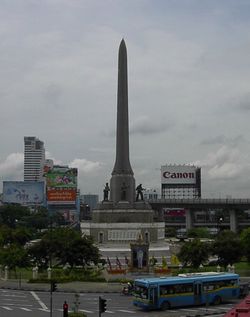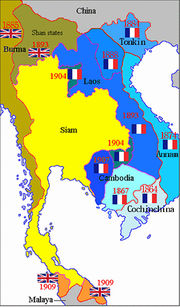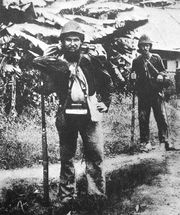Franco-Thai War
|
||||||||||||||||||||||||||||||
|
||||||||||||||||||||||||||||||
|
||||||||||||||||||||||||||||||
The Franco-Thai War (Thai: กรณีพิพาทอินโดจีน or สงครามอินโดจีน ครั้งที่ French: Guerre franco-thaïlandaise) (1940–1941) was fought between Thailand and Vichy France over certain areas of French Indochina that had once belonged to Thailand.
Negotiations with France shortly before World War II had shown that the French government was willing to make appropriate changes in the boundaries between Thailand and French Indochina. Following the Fall of France in 1940, Major-General Plaek Pibulsonggram (popularly known as "Phibun"), the prime minister of Thailand, decided that France's defeat gave the Thais an even better chance to regain the territories they had lost during King Chulalongkorn's reign.
The German occupation of metropolitan France made France's hold on its overseas possessions, including Indochina, tenuous. The isolated colonial administration was cut off from outside help and outside supplies. After the Japanese invasion of Indochina in September 1940, the French were forced to allow Japan to set up military bases. This seemingly subservient behavior convinced the Phibun regime that Vichy France would not seriously resist a confrontation with Thailand.
Contents |
The opposing forces

French forces in Indochina consisted of an army of approximately fifty thousand men, of whom twelve thousand were French, organised into forty-one infantry battalions, two artillery regiments, and a battalion of engineers.[7] The most obvious deficiency of the French army lay in its shortage of armour: it could only field twenty antiquated Renault FT-17s against around one hundred armoured vehicles of the Royal Thai Army. The bulk of the French forces stationed near the frontier with Thailand comprised Indochinese troops of the 3rd and 4th Tirailleurs Tonkinois (Tonkinese Rifles) together with a battalion of Montagnards, French regulars of the Colonial Infantry and Foreign Legion units[8].
The Armée de l'Air had in its inventory approximately a hundred aircraft, of which around sixty could be considered first line. These consisted of thirty Potez 25 TOEs, four Farman 221s, six Potez 542s, nine Morane-Saulnier M.S.406, and eight Loire 130 flying boats.[9]

The Thai Army was a relatively well-equipped force. Consisting of 60,000 men,[10] it was made up of four armies, the largest of which was the Burapha Army with its five divisions. Independent formations under the direct control of the army high command included two motorised cavalry battalions, one artillery battalion, one signals battalion, one engineer battalion and one armoured regiment. The artillery had available a mixture of aged Krupp and modern Bofors howitzers and field guns, while sixty Carden Loyd tankettes and thirty Vickers six-ton medium tanks made up the bulk of the army's tank arm.
The Royal Thai Navy–consisting of several vessels, including two coastal defence ships, twelve torpedo boats and four submarines–was inferior[11] to the French naval forces, but the Royal Thai Air Force held both a quantitative and qualitative edge over l'Armee de l'Air.[12] Among the 140 aircraft that composed the air force's first-line strength were twenty-four Mitsubishi Ki-30 light bombers, nine Mitsubishi Ki-21 medium bombers, twenty-five Hawk 75Ns pursuit planes, six Martin B-10 medium bombers, and seventy O2U Corsair light bombers.[13]
War
.svg.png)
While nationalistic demonstrations and anti-French rallies were held in Bangkok, border skirmishes erupted along the Mekong frontier. The superior Royal Thai Air Force conducted daytime bombing runs over Vientiane, Sisophon, and Battambang with impunity. The French retaliated with their own planes, but the damage caused was less than equal. The activities of the Thai air force, particularly in the field of dive-bombing,[14] was such that Admiral Jean Decoux, the governor of French Indochina, grudgingly remarked that the Thai planes seemed to have been flown by men with plenty of war experience.[15]

In early January 1941, the Thai Burapha and Isan Armies launched their offensive on Laos and Cambodia. French resistance was instantaneous, but many units were simply swept along by the better-equipped Thai forces. The Thais swiftly took Laos, but Cambodia was more difficult to take.
At dawn on January 16, 1941 the French launched a large counterattack on the Thai-held villages of Yang Dang Khum and Phum Preav, initiating the fiercest battle of the war. Because of over-complicated orders and nonexistent intelligence, the French counterattacks were stopped and fighting ended with a French withdrawal from the area. The Thais were unable to pursue the retreating French, as their forward tanks were kept in check by the gunnery of French Foreign Legion artillerists.
As the situation on land was exacerbating for the French, Admiral Decoux ordered the available French naval forces into action in the Gulf of Thailand. In the early morning of January 17, the French navy caught a Thai naval detachment at anchor off the island of Ko Chang. The subsequent Battle of Ko Chang proved a victory for the French and resulted in the sinking of two Thai torpedo boats and a coastal defence ship.
On January 24, the final air battle took place when Thai bombers raided the French airfield at Angkor near Siem Reap. The last Thai mission commenced at 0710 hours on January 28, when the Martins of the 50th Bomber Squadron set out on a raid on Sisophon, escorted by thirteen Hawk 75Ns of the 60th Fighter Squadron.[16][17]
The Japanese mediated the conflict, and a general armistice was arranged to go into effect at 1000 hours on January 28. On May 9 a peace treaty was signed in Tokyo,[18][19] with the French being coerced by the Japanese into relinquishing their hold on the disputed territories.
Aftermath

The resolution of the conflict was received with wide acclaim among the Thai people and was looked upon as a personal triumph for Phibun. For the first time, Thailand had been able to extract concessions from a European power, albeit a weakened one. For the French in Indochina, the conflict was a bitter reminder of their isolation following the Fall of France. In the French view, an ambitious neighbour had taken advantage of a distant colony cut off from her weakened parent. Without hope of reinforcements, the French had little chance of offering a sustained resistance. But in the Thai view, the French had unfairly taken those areas which used to be parts of Siam (Thailand). And then the French-Thai War was a reasonable effect.
However, the real beneficiaries of the conflict between Thailand and the Vichy French colony were the Japanese. They were able to expand their influence in both Thailand and Indochina.
The Japanese won from Phibun a secret verbal promise to support them in an attack on British Malaya and British Burma.[20] However, the Thai Prime Minister was fickle and he was quite ready to forget this promise if circumstances changed. His government also asked both the British and Americans for guarantees of effective support if Thailand were invaded by Japan.
On 8 December 1941, the Japanese invaded Thailand at the same time they invaded Malaya (immediately after the attack on Pearl Harbor, Hawaii, USA).
After the war, in October 1946, northwestern Cambodia and the two Lao enclaves on the Thai side of the Mekong River were only returned to French sovereignty after the French provisional government threatened to veto Thailand's membership in the United Nations.[21]
Casualties
The French army suffered a total of 321 casualties, of whom 15 were officers. The total number of men missing after January 28 was 178 (6 officers, 14 non-commissioned officers, and 158 enlisted men).[22] The Thais had captured 222 men (17 North Africans, 80 Frenchmen, and 125 Indochinese).[23]
The Thai army suffered a total of 54 men killed in action and 307 wounded.[24] 41 sailors and marines of the Thai navy were killed, and 67 wounded. At the Battle of Ko Chang, 36 men were killed, of whom 20 belonged to HTMS Thonburi, 14 to HTMS Songkhla, and 2 to HTMS Chonburi. The Thai air force lost 13 men. The number of Thai military personnel captured by the French amounted to just 21.
About 30% of the French aircraft were rendered unserviceable by the end of the war, some as a result of minor damage sustained in air raids that remained unrepaired.[25] The Armée de l'Air admitted the loss of one Farman F221 and two Morane M.S.406s destroyed on the ground, but in reality its losses were greater.[26]
In the course of its first experience of combat, the Royal Thai Air Force claimed to have shot down five French aircraft and destroyed seventeen on the ground, for the loss of three of its own in the air and another five to ten destroyed in French air raids on Thai airfields.
See also
- France-Thailand relations
Notes
- ↑ Fall, p.22. "On the seas, one old French cruiser sank one-third of the whole Thai fleet ...,Japan, seeing that the war was turning against its pupil and ally, imposed its "mediation" between the two parties."
- ↑ Tucker, p. 552
- ↑ Fall, pg.22. ..the French were forced to surrender to Thailand three provinces in Cambodia and two provinces in Laos.
- ↑ Windrow, pg. 78 five provinces in Cambodia and Laos provinces were handed over to Siam.
- ↑ Windrow, pg. 78
- ↑ Royal Thai Air Force. (1976) The History of the Air Force in the Conflict with French Indochina. Bangkok.
- ↑ Stone, Bill. "Vichy Indo-China vs Siam, 1940-41". http://www.sonic.net/%7Ebstone/history/vichyvssiam.shtml.
- ↑ page 90 "Les Linh Tap", Maurice Rives, ISBN 2-7025-0436-1
- ↑ Ehrengardt, Christian J. and Shores, Christopher. (1985) L'Aviation de Vichy au combat: Tome 1: Les campagnes oubliées, 3 juillet 1940 - 27 novembre 1942. Charles-Lavauzelle.
- ↑ Hesse d'Alzon, Claude. (1985) La Présence militaire française en Indochine. Château de Vincennes: Publications du service historique de l'Armée de Terre.
- ↑ Young, Edward M. (1995) Aerial Nationalism: A History of Aviation in Thailand. Smithsonian Institution Press.
- ↑ Ibid.
- ↑ Royal Thai Air Force. (1976) The History of the Air Force in the Conflict with French Indochina. Bangkok.
- ↑ Young, Edward M. (1995) Aerial Nationalism: A History of Aviation in Thailand. Smithsonian Institution Press.
- ↑ Elphick, Peter. (1995) Singapore: the Pregnable Fortress: A Study in Deception, Discord and Desertion. Coronet Books.
- ↑ Ehrengardt, Christian J. and Shores, Christopher. op. cit.
- ↑ Royal Thai Air Force. (1976) The History of the Air Force in the Conflict with French Indochina. Bangkok.
- ↑ Young, Edward M. (1995) Aerial Nationalism: A History of Aviation in Thailand. Smithsonian Institution Press.
- ↑ Hesse d'Alzon, Claude. op. cit.
- ↑ Charivat Santaputra (1985) Thai Foreign Policy 1932-1946. Thammasat University Press.
- ↑ Terwiel, B.J. (2005) Thailand's Political History: From the Fall of Ayutthaya to Recent Times. River Books.
- ↑ Hesse d'Alzon, Claude. op. cit.
- ↑ Royal Thai Air Force. (1976) The History of the Air Force in the Conflict with French Indochina. Bangkok.
- ↑ Sorasanya Phaengspha (2002) The Indochina War: Thailand Fights France. Sarakadee Press.
- ↑ Young, Edward M. (1995) Aerial Nationalism: A History of Aviation in Thailand. Smithsonian Institution Press.
- ↑ Ehrengardt, Christian J. and Shores, Christopher. op. cit.
References
- Fall, Bernard B. (1994). Street Without Joy: The French Debacle in Indochina. Stackpole Books. ISBN 0811717003.
- Windrow, Martin. 2004. The Last Valley. Weidenfeld and Nicolson. ISBN 0-306-81386-6
- Tucker, Spencer (2005). Encyclopedia of World War II: A Political, Social, and Military History. ABC-CLIO. ISBN 1576079996.
- Wong, Ka F. Visions of a Nation: Public Monuments in Twentieth-Century Thailand, White Lotus, Bangkok 2006
External links
|
|||||||||||||||||||||||||||||||||||||||
|
|||||||||||||||||||
| Office holders | Individuals and institutions | Key events | |||
|---|---|---|---|---|---|
|
The Monarchy
Prime Ministers of Thailand
|
Military
Others
Institutions |
Key events
|
|||
.jpg)


